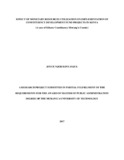| dc.contributor.author | Kinyanjui, Joyce Njeri | |
| dc.date.accessioned | 2018-10-29T09:58:57Z | |
| dc.date.available | 2018-10-29T09:58:57Z | |
| dc.date.issued | 2017-06 | |
| dc.identifier.uri | http://hdl.handle.net/123456789/3612 | |
| dc.description | Master of Public Administration, 2017 | en_US |
| dc.description.abstract | The Constituency Development Fund (CDF) was established by an Act of parliament in Kenya in the year 2003 with an aim of ensuring equitable resource allocation to all constituencies which are the electoral zones. The allocation of funds is pegged on the poverty index and the population of the constituencies as a driving factor. Despite the CDF role in alleviating poverty and improving economic growth index in Kenya, most of the constituencies continues’ to experience high poverty levels. The economic growth index remains 5.6% compared to 6.9% and 6.5% growth for Tanzania and Rwanda respectively. Uganda follows closely at 5.2%. Researchers and government monitoring agencies in mitigating the trend have borne no fruit. Global studies on CDF have concentrated on project selection and planning whereas in Kenya, studies have focused on “professionalizing” CDF monitoring structures and improving their capacity. None has been conducted in monetary resource utilization and implementation of CDF projects in Kenya. The ignored variables might be of great significant to the problem facing the implementation of CDF projects in Kenya, particularly in Kiharu Constituency, Murang’a County. The main objective was to find out the effect of monetary resources utilization and its effect on implementation of CDF projects in Kenya whereas the specific objectives were; managerial practices, monitoring and evaluation, procurement processes and governance. Drawing from the fiscal interest theory and economic welfare theory it was conceptualized that the independent variable and dependent variable were monetary resource utilization and implementation of CDF projects respectively. The unit of the study was Kiharu Constituency. The study adopted the descriptive survey design method and a population of thirty seven (37) respondents was used. It was a census study with a response rate of 87% hence reliability and validity of research. Primary data was collected using self-administered questionnaires. This was supplemented by secondary data obtained from the Kiharu constituency’s CDF reports. The data was analyzed using descriptive and inferential statistics. The study revealed that: (n=14) (43.8%) of managerial practices influenced positively the implementation of CDF projects in Kiharu Constituency. Monitoring and evaluation positively influence CDF implementation giving results of (53%). Most of the respondents (59.4%) deemed the members of the project management committees as well versed with the procurement procedures in place. The mode of project identification for the programs undertaken by CDF was predominantly found to be popular public participation in project determination (53%). In conclusion and contrary to prior research this study has revealed that: the managerial skills of the project management committee members affected their outlook to projects being undertaken. The mediums of technology management used by the project management committee assured sound monitoring and evaluation programs in the CDF projects. The capacity to confer the project management committees with financially literate persons was constrained and this limited the capacity of the CDF Act, 2003 with regard to ensuring optimal procurement management. The local communities in most cases took a common approach as regards the project choice thus an indication of the fact that communal interests were the guiding parameter in project choice determination. The study recommended that: The Kiharu CDF should place emphasis on the training of the project management committee members as a premise of ensuring that they have the requisite skills to carry out their managerial activities effectively. Capacity building for monitoring and evaluation activities should be carried out on the part of the fund. The Kiharu CDF should streamline the procurement processes in place with a view of enhancing their capacity to mitigate against the risks of losses to the institution. The governance practices should emphasis on enhancing the stakeholder participation via public forums effectively advertised for all and sundry. In conclusion this study has revealed that monetary resource utilization enhances implementation of CDF projects thereby advancing the theories. Moderators and other designs may be considered in future studies. | en_US |
| dc.description.sponsorship | Murang'a University of Technology | en_US |
| dc.language.iso | en | en_US |
| dc.title | EFFECT OF MONETARY RESOURCES UTILIZATION ON IMPLEMENTATION OF CONSTITUENCY DEVELOPMENT FUND PROJECTS IN KENYA (A case of Kiharu Constituency Murang’a County) | en_US |
| dc.type | Thesis | en_US |

